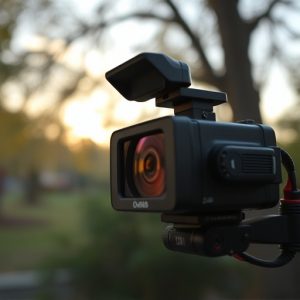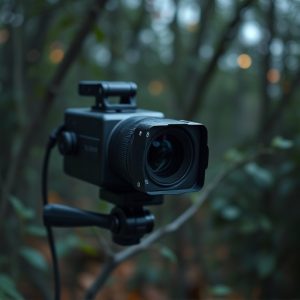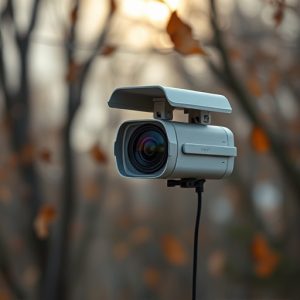Detect Hidden Cameras: RF Sweep Tutorial for Indoor Night Vision Safety
RF (Radio Frequency) detectors are powerful tools for locating hidden indoor spy cameras with night…….
RF (Radio Frequency) detectors are powerful tools for locating hidden indoor spy cameras with night vision, capable of scanning and identifying radio signals from covert surveillance equipment in dark or visually impaired environments. To use an RF detector effectively, prepare the area by choosing well-lit spaces, strategically placing cameras using their night vision, and calibrating the detector to detect the camera's frequency range. The process involves systematically sweeping the detector across the space; unusual or erratic signal patterns may indicate hidden cameras. Regular practice in controlled settings and understanding environmental factors that can interfere with RF signals are crucial for accurate results.
Uncover hidden threats with an RF detector sweep—a powerful tool in the fight against indoor spy cameras equipped with night vision. This comprehensive tutorial guides you through every step, from understanding RF detectors and their crucial role in camera detection to setting up your environment and interpreting results. Learn advanced tips and precautions for effective use, empowering you to identify and disable hidden cameras once and for all.
- Understanding RF Detectors and Their Role in Camera Detection
- Setting Up Your Environment: Indoor Spy Camera with Night Vision
- The Process of Detecting Hidden Cameras Using RF Sweep
- Interpreting Results and Identifying Potential Spy Cameras
- Advanced Tips and Precautions for Effective RF Detector Use
Understanding RF Detectors and Their Role in Camera Detection
RF (Radio Frequency) detectors are crucial tools in the quest to uncover hidden indoor spy cameras equipped with night vision capabilities. These devices operate by scanning and analyzing radio signals, which play a vital role in detecting active cameras that might be surreptitiously installed. In the realm of security, RF detectors have emerged as game-changers, offering a means to navigate the labyrinthine world of covert surveillance.
By utilizing specific frequencies, RF detectors can pick up on the wireless transmissions emitted by indoor spy cameras, even those operating in the dark with night vision features. This capability is particularly useful in environments where visual inspections are challenging or impossible. Thus, when it comes to detecting hidden cameras, understanding RF technology and its integration with detector devices is essential for ensuring a comprehensive security approach, especially in places like homes or offices where privacy and confidentiality are paramount.
Setting Up Your Environment: Indoor Spy Camera with Night Vision
Setting up your environment for an RF detector sweep of a hidden indoor spy camera with night vision involves preparing a space that mimics the conditions where the device might be operating. Start by identifying a room or area within your home or office that requires surveillance, ensuring it’s well-lit to aid in the detection process. Place the indoor spy camera strategically, utilizing its night vision capabilities to capture clear images even in low-light conditions. This step is crucial for effective monitoring, as night vision ensures continuous surveillance without sacrificing visibility.
Next, ensure your RF detector is properly calibrated and compatible with the frequency ranges typical of such cameras. Test it in an empty room to familiarize yourself with its range and sensitivity settings. By setting up your environment carefully, you create an optimal condition for detecting hidden indoor spy cameras, leveraging the night vision feature while relying on advanced RF detection technology.
The Process of Detecting Hidden Cameras Using RF Sweep
Detecting hidden cameras using an RF (Radio Frequency) sweep is a meticulous process designed to uncover clandestine surveillance devices, including indoor spy cameras with night vision. The first step involves identifying potential locations where hidden cameras might be installed, such as corners, ceiling junctions, and behind furniture. Once these areas are identified, the RF detector is carefully swept across the space. This device emits radio signals that can be intercepted by active cameras, triggering their operation to reveal their presence.
During the sweep, it’s crucial to maintain a systematic approach, ensuring thorough coverage without missing any corners or crevices. The detection process relies on the fact that many hidden cameras are equipped with wireless transmitters that respond to RF signals, causing them to turn on and transmit data temporarily. This brief activation provides a clear indication of the camera’s location, allowing for its safe removal and preventing further unauthorized surveillance.
Interpreting Results and Identifying Potential Spy Cameras
When conducting an RF detector sweep, interpreting the results is a crucial step in identifying potential hidden cameras. The device will emit signals when it detects radio frequency emissions from devices like indoor spy cameras with night vision. Pay close attention to any unusual or erratic signal patterns, as these could indicate the presence of a hidden camera. Look for sudden spikes or fluctuations in signal strength, which might suggest the camera’s activation or data transmission.
To confirm the discovery, inspect the areas where signals are strongest. These spots often serve as the camera’s position. Remember that modern spy cameras can be incredibly small and discrete, so it’s essential to use a sensitive RF detector and scan thoroughly. If you suspect a hidden camera based on the sweep results, further investigation using other tools and methods is recommended to ensure complete detection and mitigate potential privacy risks.
Advanced Tips and Precautions for Effective RF Detector Use
When using an RF detector for locating hidden cameras, especially indoor spy cameras with night vision, remember that practice makes perfect. Regularly test your detector in controlled environments to familiarize yourself with its capabilities and limitations. This is crucial as it allows you to adjust settings and understand the specific signals your device picks up.
Additionally, always consider the environment. Different materials and structures can interfere with radio frequency (RF) signals. Be aware of potential obstructions like metal objects, walls, or electronic devices that might disrupt the detector’s performance. Adjusting your position and moving away from these obstacles can significantly enhance accuracy.
RF detector sweep technology offers a powerful tool in the fight against hidden indoor spy cameras with night vision. By understanding how these detectors operate and following the step-by-step process outlined in this tutorial, you can effectively identify and locate covert surveillance devices. Remember that prevention is key; taking precautions to secure your living and working spaces is crucial for maintaining privacy. With this knowledge, you’re equipped to protect yourself from unwanted intrusions into your personal or professional life.


